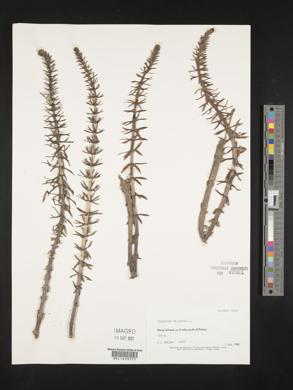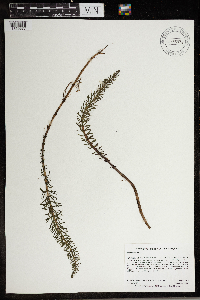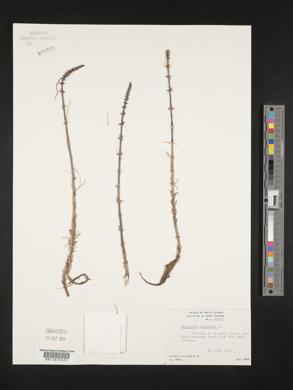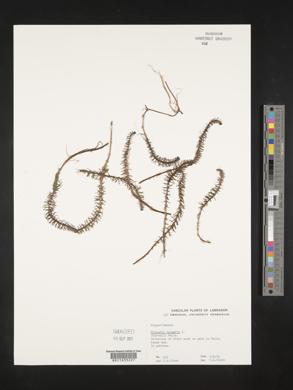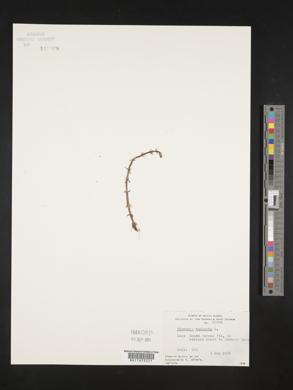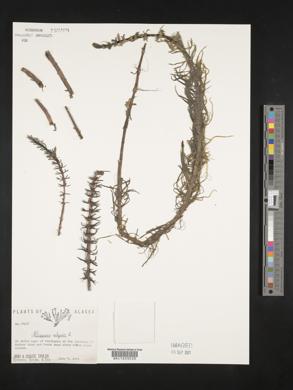Hippuris vulgaris
|
|
|
|
Family: Plantaginaceae
Common Mare's-Tail, more...common marestail, marestail
[Hippuris tetraphylla f. lacunarum Dutilly & Lepage] |
Plant: perennial, aquatic or amphibious herb, of brackish and fresh water, generally glabrous; AERIAL STEMS mostly 20-60 (-100) cm tall Leaves: mostly 5-35 mm long, 1-3 mm wide; whorled in sets of (4-)6-12(-16), simple, estipulate; margins entire; submersed leaves slender, thin and flaccid, often soon degenerating; aerial leaves thicker and firmer, numerous and rather crowded, linear-attenuate Flowers: solitary in upper leaf axils, inconspicuous, sessile or the lower on short pedicels; perfect or rarely imperfect, occasionally polygamous; calyx reduced to an inconspicuous, 2-4-lobed or subentire rim around the top of the ovary; petals none; stamen 1, with a short, slender filament and a large 2-celled sagittate anther; pistil simple, the ovary inferior, unicarpellate; style terminal, elongate, slender, generally lying in the groove between the two anther sacs, with anthers 1 mm long, 0.5-1 mm wide, the filament about as long; style 1-2 mm long Fruit: FRUITS ellipsoid-obovoid, 1.7-2.5 mm long, 1 mm wide Misc: Rooted in mud of shallow, standing or slow-moving water, and in wet meadows; 2300-2850 m (7600-9400 ft); Jun-Jul (fr. Jul-Aug) REFERENCES: Ricketson, Jon. 1995 Hippuridaceae. J. Ariz. - Nev. Acad. Sci. 29(l): 25. Perennial aquatic herb 20 cm - 1 m tall Stem: emersed, soft but erect, usually unbranched, hollow. Leaves: whorled, stalkless, thin and often soon degrading when submersed, thick and firm when emersed, the many crowded emersed leaves 1 - 3 cm long and 1 - 3 mm wide. Flowers: borne solitary in the leaf axils, stalkless, tiny, with sepals reduced to a small tube around the ovary, zero petals, a single stamen, and a single pistil. Fruit: an achene 1.7 - 2.5 mm long. Similar species: No information at this time. Flowering: June Habitat and ecology: Rare in streams and ponds. Occurence in the Chicago region: native Etymology: Hippuris is the Greek name meaning horse-tailed. Vulgaris means common. Author: The Morton Arboretum Stems soft but stiffly erect, unbranched, mostly 2-6(-10) dm, the internodes of the submersed part often longer than the lax, thin lvs, which may soon degenerate; emersed lvs thicker and firmer, numerous and rather crowded, usually widely spreading, linear, 1-3 cm נ1-3 mm; fls sessile; frs 1.7-2.5 mm; 2n=32. In shallow, quiet water, or seldom on mud; circumboreal, in Amer. s. to Me., n. N.Y., n. Ind., Io., and N.M.; Australia and s. S. Amer. A salt-marsh form with elliptic obtuse lvs in 4's has been called f. maritima Hellenius. (H. tetraphylla) Gleason, Henry A. & Cronquist, Arthur J. 1991. Manual of vascular plants of northeastern United States and adjacent Canada. lxxv + 910 pp. ©The New York Botanical Garden. All rights reserved. Used by permission. From Flora of Indiana (1940) by Charles C. Deam Our only specimen is one collected by E. J. Hill, July 5, 1880 in a millpond near Otis, La Porte County. This specimen is in the herbarium of the University of Illinois. The species has been reported from Kosciusko and Lake Counties and from the Lower Wabash Valley by Schneck, who says it is "rare in ponds and streams." ...... Indiana Coefficient of Conservatism: C = 10 Wetland Indicator Status: OBL |


